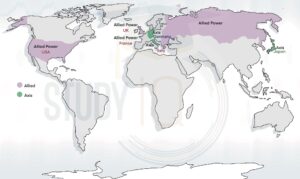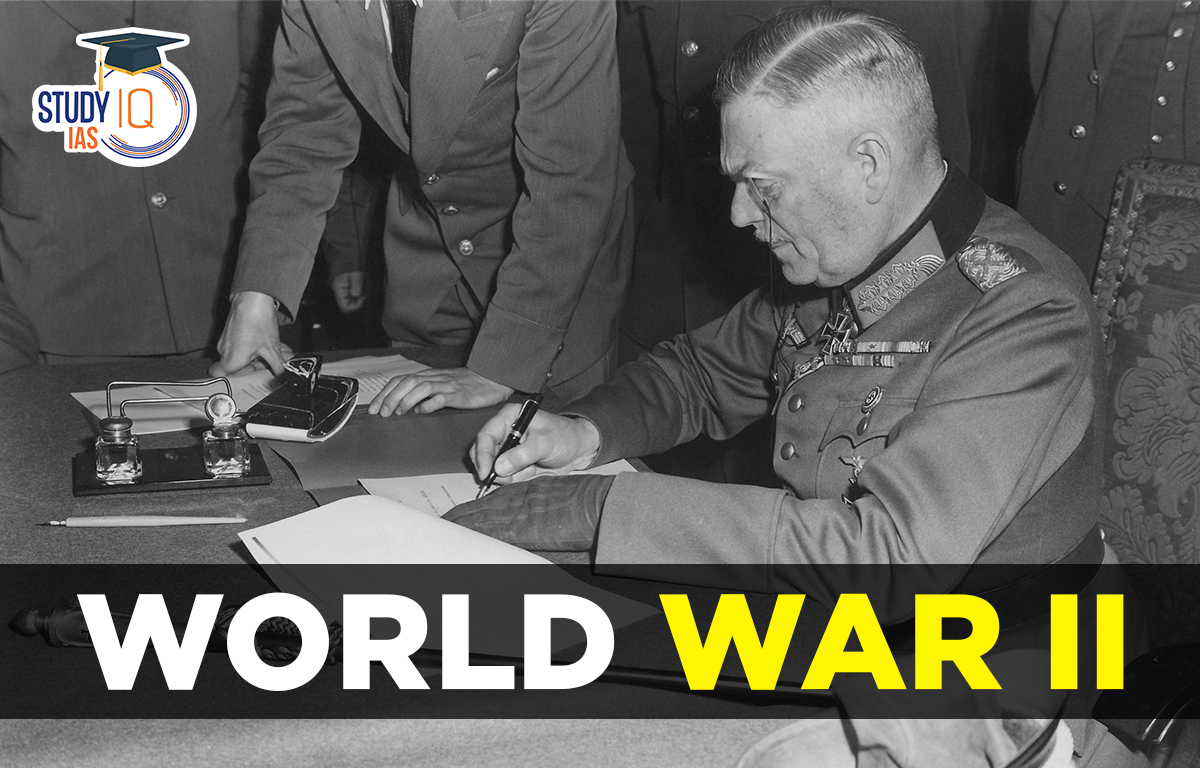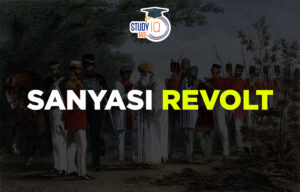Table of Contents
World War 2
World War 2 was a Global war, fought throughout the world, involving almost all the countries, directly or indirectly, happened on land, water, and air. It is also called a Total war, because it involved all the resources of a country, like factories, industry, labour, and soldiers. It started on 1st Sep 1939 and ended in Aug 1945, costing 60-80 million deaths, which included 50 million civilians and 25 million soldiers. It was one of the deadliest conflicts, in human history ever witnessed. Some historians mark 2nd Sino-China war as the starting date for World War 2.
Read More: World War 1
World War 2 Countries
There were two main groups in World War 2 i.e, Allied Powers and Axis Powers.
| Allied Powers | Axis Powers |
|
|
Read More: Industrial Revolution
World War 2 Map
Here is the World War 2 Countries Map for a better understanding of which countries supported which power.

World War 2 Causes
There were various reasons that were responsible for World War 2 described below in detail:
The Unjust Treaty of Versailles (1919)
Allied powers after the end of World War I forced Germany to sign the Treaty of Versailles Taking advantage of the treaty, France took vengeance on Germany. She humiliated Germany for the next 20 years. Under this treaty lost its territories and was also prohibited to maintain a large army. The humiliation that Germany faced after the first World War led to the spread of Ultra-Nationalism in Germany.
Demands of Imperialism
New Imperialists, like Japan and Germany, wanted to compete with old Imperialist nations such as the UK, France, etc., for resources and various territories in Africa and Asia.
Read More: French Revolution
Failure of the League of Nations
It was formed in 1919 after the end of World War I with the intention to check military aggression, it also intended that all its member and disputes between different nations could be settled through negotiations instead of aggression. League of Nations failed to maintain to settle disputes between nations as Italy invaded Ethiopia, Japan invasion of Manchuria in China and not all countries joined the league.
Great Depression of 1929
It was the worst economic disaster in the history of the Industrialized world it took its way differently in Europe and Asia. In European nations such as Germany, Italy, and Spain, the political power shifted from totalitarian to imperialist government, whereas in Asia recourse less Japan opted for an aggressive expansionist policy by invading China and trying to control the Pacific.
Read More: American Revolution
Rise of Imperialism in Japan
Japan was becoming very aggressive. Taiwan became the first colony of Japan in 1895. In 1931, Japan invaded the territories of Manchuria of China and all islands all around the Pacific Ocean. War in Asia started mainly due to the 2nd Sino-Japanese war of 1937. These concerned USA, so the US declared war on Japan on December 8, 1941, one day after Japan attacked Perl Harbour.
Rise of Hitler and NSDAP
The National Socialist German Workers Party, commonly known as the Nazi Party, was anti-semitic (anti-Jews), anti-Marxist, believed in the Superiority of the Aryan Race, and that all other races should be excluded. Hitler became Chancellor (PM) of Germany in January 1933, though he was elected, it was not a complete majority, rather hung Parliament still he was called to make government, and slowly, he transformed into a Dictator.
After the treaty of Versailles, Germany was not allowed to make an army. But Hitler started building a huge army and air force. He allotted special symbols for Jews people to distinguish them from the mass. He also declared to restore the glory of Fatherland.
Read More: Russian Revolution 1917
Events Leading to Second World War
There the subsequent major events occurred that led to the Second World War.
Events Around 1936: Hitler re-militarized the Rhineland in. Although as per the Treaty of Versailles, it was decided not to militarize the area, because it was a threat to France. There was a treaty between Italy and Germany, called Rome-Berlin Axis, from this event the name Axis Power came into the picture. Later, Germany signed a pact with Japan too.
1938 German Annexation: Hitler annexed the entire area of Austria, and the process was called Anschluss. Hitler claimed that Austria had historically been a part of Germany. It was never supposed to be a different country. It was artificially created after WWI. So, he demanded Austria become part of Germany again. Initially, it was a bloodless coup. The people of Austria welcomed Hitler. Sudetenland was annexed by Germans; it lay on the border of Czechoslovakia and Germany and Hitler claimed that area too.
The allied countries thought that it was just a matter of 1-2 countries, and then Hitler would stay silent. They didn’t want war for a small country like Austria, So, they didn’t stop Hitler from doing so. This let Hitler think that UK & France were weak and didn’t want war.
Events Around 1938: Hitler after annexing Sudetenland attacked and conquered the entire Czechoslovakia in March 1939. Still, no country said against Hitler. The next target was Poland- but it was promised protection by UK & France. There was a pact between Germany and USSR, called Molotov Ribbentrop Pact, by which USSR was bound to help Germany in war. Because he knew that sooner or later, he would have to go to war against UK & France.
Read More: Rowlatt Act
World War 2 Started in 1939
On 1st September Germany attacks Poland from the west and USSR also attacked Poland from the east. As a result, UK & France declared war on Germany but couldn’t save Poland. Then, Germany took control of western Poland and the USSR took control of eastern Poland. Soon, in 1940, it also annexed the Baltic nation of Estonia, Latvia and Lithuania.

In the early 1940s, after invading Poland, Hitler invaded Denmark &Norway. He attacked Norway because from there he wanted to attack Finland. Then he went on to attack Belgium & Netherlands. They fell to the Blitzkrieg campaign of Germany. Blitzkrieg is a war tactic, which is a fast, sudden military offensive, usually combining ground forces with air support. It took a few days to conquer Belgium, and Denmark and a couple of weeks to conquer the Netherlands and a month for Norway.
USSR occupied Baltic states and Finland, using the Molotov pact. Then, Italy also joined and invades France in June. Germany invades France on 10th June and on 14 June, Paris fell. Germany attacked many cities in Britain, like London, Birmingham, etc. through aerial bombing, continuously for many months. This was called the Blitz.
The objective behind this attack was to get Britain to sign a peace treaty which didn’t happen. After a few months, Britain successfully repealed the attack. This was a huge setback for the UK. Earlier, the UK thought that no one could attack their homeland directly, but Germany under Hitler did.
The Tripartite Pact of Germany, Italy, and Japan. To strengthen the pact Germany signed a common pact with Italy and Japan. These countries came to be known as Axis Powers. Later, Hungary, Bulgaria, and Romania also joined the Axis power.
In 1941, British forces from Egypt pushed back Italians in Libya, but later German reinforcement arrived and sent the British back to Egypt. Then, Germany invaded Yugoslavia and Greece. So, Germany overruns the entire Central and Southern Europe.
Read More: Khilafat Movement
Operation Barbarossa 1941
Axis power attacked USSR in June 1941 although, there was a peace treaty with USSR, still Hitler attacked it. Because, he wanted to have Lebensraum – living space since Germany was expanding, it required more land to grow crops.
So, he started Operation Barbarossa. It is considered to be the largest land-army operation ever carried out. They started the attack in June, but couldn’t win everything by Oct-Nov, and when the harsh Russian winter came, the German army got bogged down, and there was a stalemate by the end of 1941.

The Pacific War
Japan had conquered large parts of Coastal China by 1940. After joining the Axis power, Japan started attacking the western colonies in China. France and Britain had colonies in Asia like Hongkong, Burma, Philippines, Indochina (Vietnam, Laos, Cambodia), Guam, Indonesia (Dutch East Indies), and Singapore (UK colony).

At that time, the USA had stopped supplying Oil to Japan. It had put Embargo. Due to this Embargo, Japan was facing difficulties. Also, Japan was under threat that, if the USA entered the war, then it would directly attack them in the Pacific. So, to prevent this, Japan did Pearl Harbour attack.
Pearl Harbour Attack
With aim of crippling the navies of the USA and the UK, Japan attacked them at multiple locations on Dec 7-8, 1941. It attacked places like Pearl Harbour (Hawaii), Malaysia, the Philippines, and Hongkong. The Pearl Harbour attack was the largest attack ever on US soil. Around 2500 soldiers died. Japan also did bombings over Australia and Papua New Guinea, colonies of the UK. After this, the USA entered the war on the side of the Allied forces
Entry of USA in 1942
Multiple battles took place between USA and Japan, throughout the islands of Pacific and South East Asia from 1942-44 Japan lost at the crucial battle of Midway and later at Guadalcanal. This turned the tide against Japan.
The Tide Turns 1942
Till 1942, Axis power was in total control of Europe. But then, the tide turned. Russians started to push back the Germans. There was a huge loss of life and a lot of war crimes on the eastern front. The USSR army pushed back Germans from Leningrad (St. Petersburg) and Stalingrad (Volgograd), and from there on victory of the USSR started. They even conquered some of the areas of Eastern Europe.
Allies also pushed back Germans and Italians from Libya. The US army attacked Morocco. Britain attacked Egypt. Tunisia won finally in 1943.
Read More: Mahatma Gandhi
Allied Powers in World War 2
The islands of Sicily and later Italy’s mainland was attacked by Allied armies. Half of the areas of Italy were conquered by the Allied forces. The northern part remained with the Italy Govt, as the area was mountainous, and it took time for Allied forces to reach there. At the same time, the dictator of Italy, Benito Mussolini was deposed and arrested by the Italian govt.
By 1944, the USSR army liberated most of Eastern Europe from Germany. Allied armies were pushing through Northern Italy and were getting closer to the Japanese mainland and capturing one island after another.
On June 6th, 1944, Allied forces landed in Northern France, near Normandy it was also called as Normandy landing, the largest amphibious (from water to land) landing ever. For the past 6 years, France was under the control of Germany. Finally, France was liberated, and the Germans were pushed back.
By 29th April Within 10 months of the Normandy landing, the German army surrendered and on 30th April 1945, Hitler committed suicide in his bunker. By mid-1945, Burma, Indonesia, Philippines were liberated by Allied forces. After defeating Germany and Italy in Europe, only Japan was remaining.
Read More: Indigo Revolt
Hiroshima & Nagasaki Atomic Bombs
To avoid a full-scale invasion of Japan’s mainland, which would have resulted in 4-5 lakhs of US soldiers dying, the USA decided to drop newly invented Atomic Bombs on Japan’s two cities. Hiroshima on 6 Aug 1945, its name was Little Boy (nickname of bombs), and Nagasaki on 9 Aug 1945 whose name was Fat man.
For the first and only time in history, a nuclear bomb was dropped on someone, and instantly 1.5 lakh people died in Nagasaki, and 80,000 people died in Hiroshima. Japan finally surrendered on 15 Aug 1945. Thus, with this end WW2
Post World War 2 Events
Beginning of Cold War (1947 – 1991) between USA and USSR. Two superpowers emerged – USA and USSR. The Cold war went on for 45 years until USSR disintegrated in 1991.
USSR, USA, UK, and France divided Germany into two blocks – East and West. Berlin Wall was erected in the middle of Germany so that people couldn’t go from East Germany to West Germany. Also, there was a huge forced transfer of populations in Easter and Central Europe.
United Nation was formed as it replaced the League of Nations as a new World Peacekeeping authority. Its main purpose was to prevent WW3.
World War 2 Summary
Here is a complete World War 2 Summary given below in the table with the Timeline:
| Timeline | Details |
| January 1933 | Hitler appointed as the German Leader |
| September 1939 | World War 2 begins |
| September 1939 | Germany and USSR invade Poland |
| September 1939 | Warsaw was Captured |
| April 1940 | Norway was invaded by Germany |
| June 1940 | Paris falls to the Nazis |
| December 1941 | Japan Attacked Pearl Harbour |
| January 1942 | Entry of the USA into the war |
| July 1942 | Battle of Stalingrad beginning of the end for the Germans |
| June 1944 | Normandy Landing, France was liberated |
| April 1945 | Hitler committed suicide in his bunker |
| August 1945 | Two Atomic Bomb over Japan bring WW II to an end |


 Maharashtra’s Mendrachi Vancharai Syst...
Maharashtra’s Mendrachi Vancharai Syst...
 Keeladi Excavation: Uncovering the Ancie...
Keeladi Excavation: Uncovering the Ancie...
 Sanyasi Revolt, Objectives, History, Rea...
Sanyasi Revolt, Objectives, History, Rea...





















